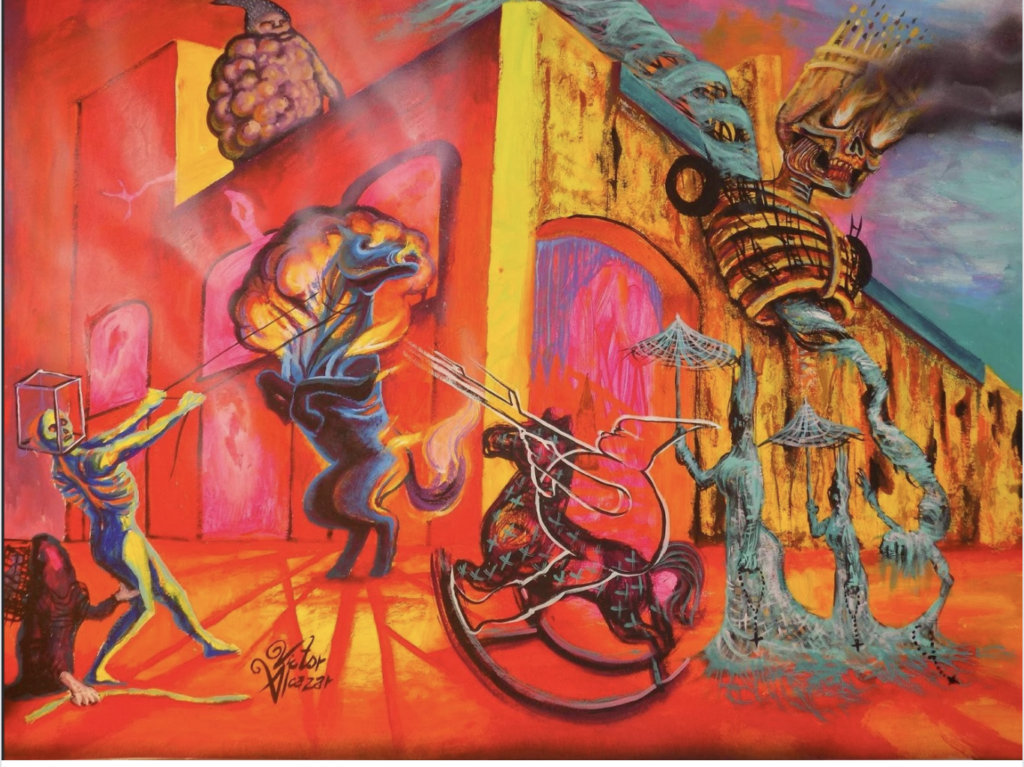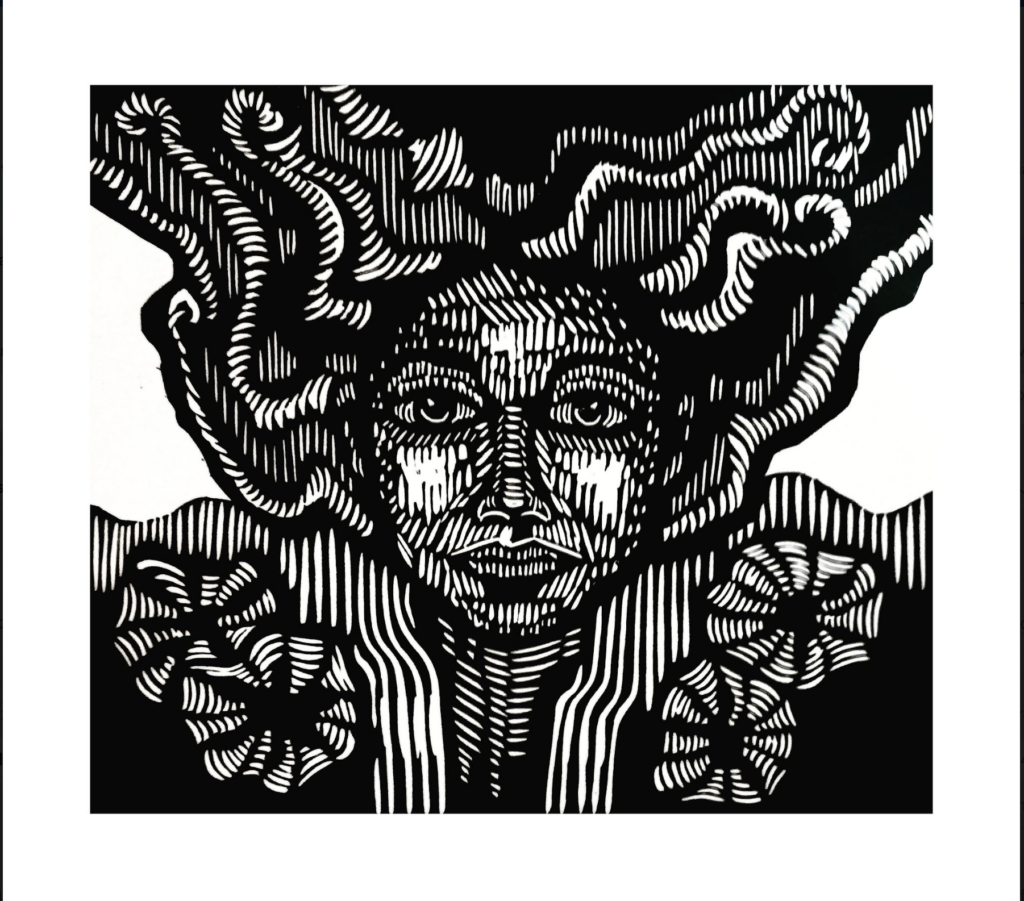By Mia Pratt
Lake Chapala’s Art of Mexican Magical Realism
Forty minutes south of Guadalajara, a talented community of Mexican magical realists have flourished quietly for decades in the historic villages lining the shores of Lake Chapala. Lakeside visitors flock to the area to wander its cobblestone roads and tour the magnificent murals gracing the walls of its plazas, streets and alleys.
The term “magical realism” was first coined by German photographer and art historian/critic Franz Roh in 1925 to describe modern realist paintings that included fantasy or dream-like elements. A more recent interpretation explains, “Magical realism is often compared to surrealism, but while surrealism focuses on the life of the mind, magical realism is grounded in the real world, showing fantastical elements as a part of everyday life…” (UGA Today).
Until recent years, magical realism was a relatively unknown genre of art outside of gallery and historian circles. However, thanks to the meteoric rise in popularity of Mexico’s Frida Kahlo, the term has entered the public lexicon. Frida Kahlo is arguably Mexico’s most famous Mexican magical realist and her image has become an iconic figure in popular culture for the enigmatic works she created from the 1920s through the 1950s. In the past few years her likeness has been reproduced on merchandise virtually everywhere. The interactive light show production “Frida – La Experiencia Inmersiva” tours the globe, other Kahlo exhibits are in play, and in March of 2023 an exhibit opened at the Museo de las Artes in Guadalajara.

This unprecedented explosion of interest in Kahlo has undoubtedly contributed to the current resurgence of interest in magical realism. In April of 2023 the prestigious Barron’s Magazine of New York published, “Among artistic themes that will play out at ‘Independent New York’ this May is an…exploration of magical realism that reflects artists drawing on interior worlds…” When New York’s finance and art circles takes notice, the world listens. Magical realism as a genre of art is being re-discovered by academia and trending on social media as a popular buzz-phrase. And in the villages of ancient Lake Chapala, Mexican magical realism has emerged from the shadows to reveal its treasures to the world.
In April of 2023 the prestigious Barron’s Magazine of New York published, “Among artistic themes that will play out at ‘Independent New York’ this May is an…exploration of magical realism that reflects artists drawing on interior worlds…” When New York’s finance and art circles takes notice, the world listens. Magical realism as a genre of art is being re-discovered by academia and trending on social media as a popular buzz-phrase. And in the villages of ancient Lake Chapala, Mexican magical realism has emerged from the shadows to reveal its treasures to the world.
The Ancient Origins of Mexican Magical Realism
Mexico’s unique form of magical realism existed long before the term was designated as an art classification by Roh in 1925. Mexico’s art of magical realism was born of mythologies originating from its ancient peoples, when life and spirit were seen as inseparable aspects of the human experience. In the
hearts and minds of the peoples who held them as sacred, depictions of Quetzalcoatl and other mythical deities portrayed in art and sculpture were surely magical and very real. So, while magical realism is a relatively modern artistic classification, Mexico’s unique form reflects a deep-rooted connection to its
origins as its artists expressed the mystical, spiritual, personal and familial aspects of its life and culture
for centuries.


Magical Realism Fuels a Modern Artistic Renaissance in Lake Chapala
Lakeside’s Mexican magical realists create colorful narrative works with symbolism unique to its mythology while others have expanded beyond the traditional into fusion. As a result the area is experiencing a modern artistic renaissance as artists incorporate new elements into their work including urban symbolism, commercial references, surrealist imagery and street graffiti. The diversity of styles evident in the original works by Lake Chapala artists is intoxicating. In recent years, the stylistic differences between the urban-surrealist influences of Guadalajara and the rural-mythological influences of Lake Chapala’s legendary magical realists have blurred. That blurring of lines and intermingling of styles has sparked a revolution with Mexican magical realism at its epicenter. In response, many of the astute collectors and art lovers who delighted in combing lakeside’s cobblestone streets and galleries in years past are returning. They arrive with fresh eyes, eager to discover exciting new works and artists as they emerge.
An Art Community Expanding Beyond Tradition
Some of Lake Chapala’s master artists studied as children in art programs facilitated by American Neill James, a philanthropist who provided art classes and scholarships for local youngsters. Starting in the 1950s, many of Lake Chapala’s masters of Mexican magical realism passed through her doors and went on to create some of Lakeside’s most historic and beloved murals. These magnificent murals are the crown jewels of Lake Chapala’s artscape, with some dating back decades while others are more recent. Visitors today may often observe local artists creating inspired works in realtime.
One thing unites all of Mexico’s artists; their work circles the heart of Mexican magical realism even as it shifts beyond its borders into other genres and realms of imagination. Shifting styles is a common trait of Mexican magical realists whose stylistic choices for artistic expression are not always manifested within a single genre. Famous Mexican magical realist Diego Rivera explored cubism, modern art, impressionism, social realism and other genres. Like Rivera, Lake Chapala’s magical realists often create in a variety of
styles. Some change styles between paintings while others change styles over time. Each artistic exploration reflects a facet of their personal point of view much like the turn of a kaleidoscope captures a unique view of its collective contents.

According to many of the Mexican artists with whom I spoke, the creative focus of Mexico’s magical realists is on freely expressing the truth of what inspires and moves them as artists, without limits or boundaries. Mexico’s historical dedication to freedom and independence is evident in the diversity of styles and originality of content in all of its artists

Lake Chapala’s Past and Present: A Mecca for the Arts
Lake Chapala is recognized for its art, historic and cultural significance, and as a bohemian mecca for artists from all over the world. It is believed that artists first traversed the rugged mountain roads between Guadalajara and the lake as early as the 1880s. Lakeside continues to attract artists seeking to enjoy its natural beauty and art-centric lifestyle. Many of the Americans, Canadians and Europeans who settled in the area take classes from local Mexican masters, participate in art festivals and exhibitions, and volunteer in support of the local arts community
Recognizing Lake Chapala’s Art and Artists
There is no way to encapsulate the talent, variety of styles and cultural significance of Lake Chapala’s magical realist artist community. From its masters of traditional magical realism to emerging artists expanding into surrealism and fusion, the diversity within Lakeside’s cross-section of ages, styles and points-of-view is staggering. It is no wonder that the artscape of Lake Chapala has become an international destination for visitors and remains a thriving center-for-the-arts for its multicultural residents.
The State of Jalisco has established the village of Ajijic as a “Pueblo Magico” in recognition of its historic importance and its cultural center is an official Heritage Site. Local government and community organizations collaborate to produce art festivals and preserve the area’s rituals and traditions. The growing attraction to Lakeside by art-loving aesthetes benefits the full palette of artists and artisans by contributing to the financial growth of the area’s local businesses and families.

The Future of Lake Chapala’s Modern Artistic Renaissance
Lake Chapala’s Mexican magical realists offer the world an intriguing view into the minds, imaginations and life experiences of a people undergoing an existential cultural shift as they toggle between traditionalism and modernity, village life and urban influences. The importance of this period of transition between the past and future of Mexican art cannot be overstated. Future art historians may well view Lake Chapala’s artistic renaissance as a revolution of sorts, a brilliant moment of transcendence in the continuum of creative and artistic passion that has flourished in Mexico since the dawn of time.
Mia Pratt is a magical realism artist, author and freelance writer living in the village of Ajijic in Lake Chapala, MX.
Explore more at www.MiaPrattFineArt.com
